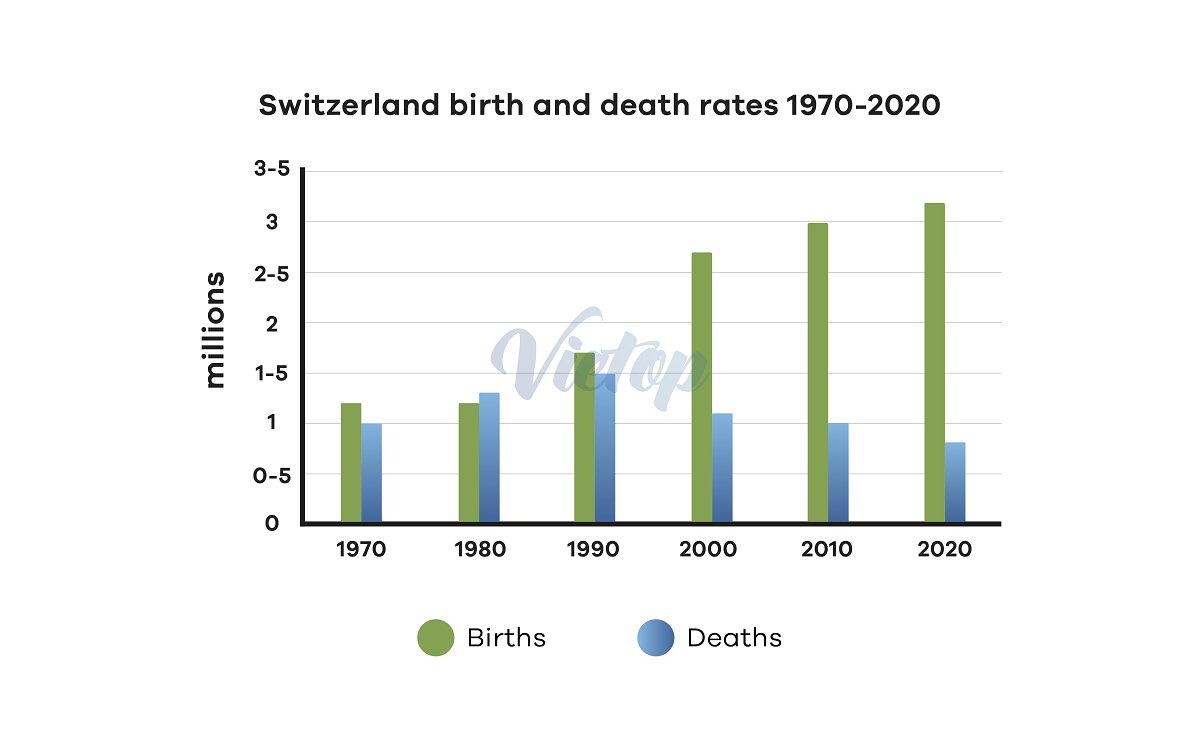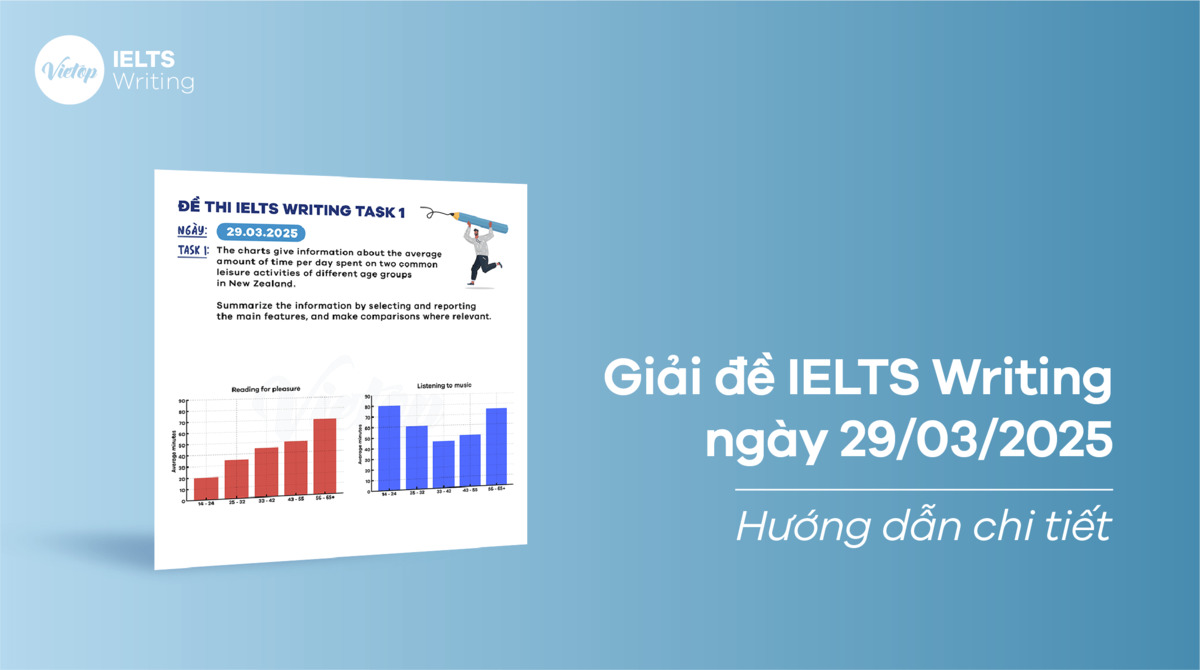Vietop gửi bạn bài giải đề Writing ngày 17/12/2022 bên dưới nhé! Các bạn theo dõi và ôn luyện IELTS Writing thật tốt nhé!
IELTS Writing Task 1
| Task 1: The chart below gives information about birth and death rates in Switzerland from 1970 to 2020 according to UN statistics. Summarise the information by selecting and reporting the main features, and make comparisons where relevant. |

Sample
The bar chart compares changes in the birth and mortality rates of Switzerland between 1970 and 2020.
Overall, the birth figure of Swiss people saw a dramatic rise while their death figure decreased for most of the recorded time. The birth rate was far higher than the deaths’, with one brief exception in 1980.
1970 and 1980 were the only times when the number of babies born in this country stayed unchanged at 1.2 million before growing to 1.7 million 10 years later. The figure for those passing away also experienced a 50% increase, reaching precisely 1.5 million in 1990.
The gap between these rates started to widen in 2000 as their trends markedly diverged. Whereas the birth rate continued a consistent climb and ended at 3.2 million, the death rate fell by 400 thousand from 1990 to 2000 and another 300 thousand in the final year of the period. Consequently, the difference between Switzerland’s birth and death statistics expanded from a marginal 100 thousand in 1980 to a massive 2.4 million in 2020.
Vocab
- mortality rate (n): tỷ lệ tử vong
- one’s trends markedly diverge: xu hướng khác nhau rõ rệt
- continue a consistent climb (v): duy trì sự tăng trưởng
- marginal (adj): không đáng kể
- massive (adj): to lớn
Phân tích
– Tỷ lệ sinh của người Thụy Sĩ đã tăng đáng kể trong khi tỷ lệ tử vong của họ giảm trong phần lớn thời gian được ghi nhận.
– Tỷ lệ sinh cao hơn nhiều so với tỷ lệ tử vong, trừ năm 1980.
– Năm 1970 và 1980 là những thời điểm duy nhất số trẻ sinh ra ở nước này không thay đổi.
– Khoảng cách giữa các tỷ lệ bắt đầu mở rộng vào năm 2000 khi xu hướng của chúng khác nhau rõ rệt.
Xem thêm:
IELTS Writing Task 2
| Task 2: In many countries people increasingly talk about money (how much they earn or how much they pay for things in their daily conversations). Why is this happening? Do you think this is a positive or a negative trend? |
Sample
There are a number of reasons why people in many countries are increasingly talking about money in their day-to-day conversations. In my opinion, though this phenomenon is justifiable in certain circumstances, it proves highly detrimental.
In today’s world of consumerism, one’s ability to afford a luxury life, and hence career success and social status, may imply sound personal finances. In fact, it is not uncommon for some people to constantly brag about their newly purchased sports cars or pay rises in gatherings. This illustrates how they derive their self-worth from discussing money and possessions. Furthermore, given the COVID-19 post-pandemic economic crisis, it comes as no surprise that bills and paychecks are causing serious concern. The increasing pressure to handle income instability provokes frequent discussions about finance as a way to vent stress and seek advice.
Heavy emphasis on monetary issues could, however, have far-reaching repercussions. Firstly, those with low incomes may avoid their high-income connections out of fear of comparison. In a broader sense, such behaviour likely exacerbates wealth inequality and inevitably puts the poverty-stricken in a position of social inferiority. This consequently discourages them from voicing their opinions about either trivial family matters or key national issues. Secondly materialism frequently involves sacrificing one’s personal life in order to acquire wealth. Without adequate time dedicated to cultivating relationships and nurturing physical and mental health, one’s well-being cannot be ensured. This disturbing trend may ultimately ignite unlawful acts due to financial constraints and a resultant feeling of social unfairness.
In summary, self-worth demonstration and economic turbulence lying behind the tendency to converse on money may contribute to the widening of social gaps, and feelings of insecurity and jealousy.
Xem thêm: Khóa học IELTS Cấp tốc – Cam kết tăng ít nhất 0.5 – 1.0 band score SAU 1 THÁNG HỌC
Vocab
- Consumerism (n): chủ nghĩa tiêu dùng
- Sound personal finance (n): tài chính cá nhân vững mạnh
- Brag about (v): khoe khoang về
- Self-worth (n): giá trị bản thân
- COVID-19 post-pandemic economic crisis (n): khủng hoảng kinh tế hậu đại dịch COVID-19
- Income instability (n): thu nhập không ổn định
- Vent stress (v): xả căng thẳng
- Have far-reaching repercussions (v): có ảnh hưởng sâu rộng
- Exacerbate wealth inequality (v): làm trầm trọng thêm bất bình đẳng giàu nghèo
- The poverty-stricken (n): những người nghèo khó
- Social inferiority (n): sự mặc cảm xã hội
- Voice one’s opinion (v): nói lên ý kiến
- Materialism (n): chủ nghĩa vật chất
- Ignite unlawful acts (v): châm ngòi các hành vi bất hợp pháp
- Financial constraint (n): hạn chế về tài chính
- Social unfairness (n): cảm giác bất công xã hội
- Economic turbulence (n): bất ổn kinh tế
- Converse on (v): trò chuyện về
Phân tích
Khía cạnh tích cực:
– Trong thế giới của chủ nghĩa tiêu dùng ngày nay, khả năng một người có thể chi trả cho một cuộc sống xa hoa có thể ám chỉ tài chính cá nhân vững mạnh.
– Do cuộc khủng hoảng kinh tế sau đại dịch COVID-19, không có gì ngạc nhiên khi các hóa đơn và tiền lương đang gây ra mối lo ngại nghiêm trọng.
Khía cạnh tiêu cực:
– Những người có thu nhập thấp có thể tránh kết nối với những người có thu nhập cao vì sợ bị so sánh.
→ Có thể làm trầm trọng thêm tình trạng bất bình đẳng giàu nghèo và chắc chắn sẽ đặt những người nghèo khổ vào vị trí thấp kém trong xã hội.
→ Không khuyến khích họ nói lên ý kiến của mình về những vấn đề gia đình nhỏ nhặt hoặc những vấn đề quan trọng của quốc gia.
– Nếu không có đủ thời gian dành riêng cho việc vun đắp các mối quan hệ và nuôi dưỡng sức khỏe thể chất và tinh thần, thì hạnh phúc của một người không thể được đảm bảo.
→ Có thể châm ngòi các hành vi bất hợp pháp do hạn chế về tài chính và cảm giác bất công xã hội.
Tham khảo:
Cách viết dạng Positive & Negative – IELTS Writing Task 2
Trọn bộ đề IELTS Writing task 1 và IELTS Writing task 2 qua từng năm
Hy vọng bài giải đề Writing ngày 17/12/2022 đã cung cấp thêm cho bạn nhiều từ vựng, cấu trúc và ý tưởng để vận dụng cho bài viết của mình khi luyện thi IELTS. Và đừng quên cập nhật liên tục đề thi IELTS writing 2022 của Vietop để chuẩn bị thật tốt cho kỳ thi sắp tới nhé! Chúc bạn thi IELTS tốt!
Xem thêm:
- [ACE THE TEST] Giải đề Writing ngày 19/11/2022
[ACE THE TEST] Giải đề Writing ngày 26/11/2022 - [ACE THE TEST] Giải đề Writing ngày 03/12/2022


![[ACE THE TEST] Giải đề IELTS Writing ngày 07/04/2025](https://vietop.edu.vn/wp-content/uploads/2025/04/giai-de-ielts-writing-ngay-07-04-2025.png)

![[ACE THE TEST] Giải đề IELTS Writing ngày 15/03/2025](https://vietop.edu.vn/wp-content/uploads/2025/03/giai-de-ielts-writing-ngay-15-03-2025.jpg)
![[ACE THE TEST] Giải đề IELTS Writing ngày 22/03/2025](https://vietop.edu.vn/wp-content/uploads/2025/03/giai-de-ielts-writing-ngay-22-03-2025.jpg)
![[ACE THE TEST] Giải đề IELTS Writing ngày 08/03/2025](https://vietop.edu.vn/wp-content/uploads/2025/03/giai-de-ielts-writing-ngay-08-03-2025.jpg)
![[ACE THE TEST] Giải đề IELTS Writing ngày 06/03/2025](https://vietop.edu.vn/wp-content/uploads/2025/03/giai-de-ielts-writing-ngay-06-03-2025.jpg)
![[ACE THE TEST] Giải đề IELTS Writing ngày 22/02/2025](https://vietop.edu.vn/wp-content/uploads/2025/02/giai-de-ielts-writing-ngay-22-02-2025.jpg)
